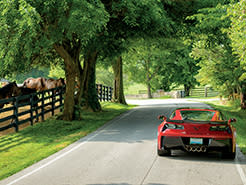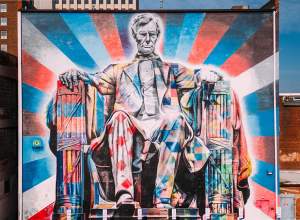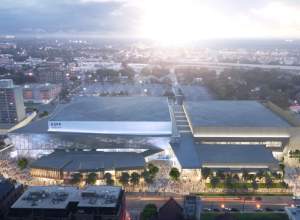Kentucky's "Timbered Tunnels" Are Rare and Scenic Connections to the Past
Covered bridges are fascinations of engineering and architecture, weathered reminders of days gone by, star attractions in scenic snapshots. Nestled along back roads like hidden jewels, they are the perfect excuse for a leisurely drive in the country.
 In Kentucky, 13 of these "timbered tunnels" remain. Though just a sampling of the more than 400 covered bridges that spanned the state's waterways in the 1800s, the peak of covered bridge development in America, Kentucky's surviving covered bridges represent a variety of construction techniques and sizes. And most are within an easy drive of Lexington.
In Kentucky, 13 of these "timbered tunnels" remain. Though just a sampling of the more than 400 covered bridges that spanned the state's waterways in the 1800s, the peak of covered bridge development in America, Kentucky's surviving covered bridges represent a variety of construction techniques and sizes. And most are within an easy drive of Lexington.
Four of Kentucky's covered bridges are still open to traffic; you can walk through the others. As you rumble across in your car, or pass your hand across the heavy wooden pegs and timbers - rough-hewn to the eye, but worn smooth by the years - you'll experience the living sensations of another era.
These charming passages through time combine with other Bluegrass-area attractions to create memorable day excursions from Lexington. Here are some suggested itineraries.
|
Bluegrass Note: Covered bridges began to be built across Kentucky rivers and creeks in the late 1700s. Some were the work of nationally known bridge architect Lewis Wernwag. Constructed with often-elaborate trusses made of wood, they were covered to keep the main timbers dry and protected from the elements, a service they also provided for travelers, their horses and their cargo in the days before automobiles and trucks. |
A "Capital" Project
In Franklin County, about a 40-minute drive from Lexington, near our state's capital city of Frankfort, stands the Switzer Bridge which spans the North Fork of Elkhorn Creek. Built in 1855 by George Hockensmith and restored in 1906 by Louis Bower, the bridge has long been lovingly tended to by the community. Despite these efforts, in March of 1997 devastating floods swept the bridge off of its foundation. Fortunately, the bridge itself was salvageable and was restored with the help of state and federal agencies. Its Howe truss structure (closed to traffic) stands 12 feet high and 120 feet long.
To reach Switzer Bridge from Lexington, take US 60 to Frankfort, turning right onto US 460. At Forks of Elkhorn, turn left onto KY 1689. About five miles down this road turn right on to SR 1262.
|
Bluegrass Note: The longest wooden covered bridge in the world once stood near the town of Butler, 7.5 miles north of Falmouth in Pendleton County, Kentucky. The Butler Station Bridge over Licking River consisted of three spans of 152 feet each, for a total length of 456 feet. The bridge was built in 1870 and 1871 at a total cost of $18,450. Severely damaged by winds and flood waters in 1937, it was torn down in September of that year. |
The Bridges of Fleming County
In Fleming County, northeast of Lexington, you can admire not just one, but three, lovely old covered bridges.
Goddard Bridge, off KY 32, about nine miles southeast of Flemingsburg, is a favorite with photographers because when viewed from the east side, it perfectly frames tiny Goddard United Methodist Church. The bridge is still open to traffic. Although the date of original construction has been lost, this 60-foot bridge spanning Sand Lick Creek was built using an 1820 patent design and is the only "town lattice truss" type bridge remaining in Kentucky. The phrase reflects the criss-crossing lattice of timbers you can see inside the bridge.
Two covered bridges remain across Fox Creek near Hillsboro, south of Flemingsburg. Grange City Covered Bridge is set amid farmland off KY 111 about four miles south of Hillsboro. The 86-foot span built in the late 1860s features a "multiple king post truss," a design in which the bridge is braced with a series of upright timbers all inclined toward the center post. One or two people can enter to take pictures, but it is not open to vehicle traffic at this time.
Of similar design, size and age is the 89-foot Ringo's Mill Bridge. To get to this bridge, turn off KY 111 onto KY 158 south from Hillsboro. The bridge takes its name from a grist mill that operated on the creek during the 1880s. Both the Grange City and Ringo's Mill bridges are closed to cars, but foot traffic is allowed.
Along the routes to the bridges you can stop at antique shops and country grocery stores. With its rolling hills and pastoral dairy farms, Fleming County is especially scenic in fall. The area is home to many Amish and Mennonite families, attracted by the rich fertile farmland. If you are in downtown Flemingsburg on a Saturday, see the Covered Bridge Museum on Water Street. It's open from noon to 4:00 p.m.
The bridges of Fleming County are about an hour and a half drive from Lexington. Take US 68 north through Paris, turning right at KY 36 toward Carlisle. If you have time, you may want to explore this small town, chock full of National Register homes and buildings. From Carlisle, take KY 32 to Flemingsburg.
|
Bluegrass Note: The loss of Kentucky's covered bridges began during the Civil War when many were burned by troops on both sides of the conflict. The number of bridges continued to decline through the 20th century, victims to modern replacements, arson and neglect. All of Kentucky's remaining covered bridges are listed on the National Register of Historic Places. A statewide program to repair and preserve Kentucky's covered bridges was announced in fall of 1996. |
From Bourbon County to Blue Licks
Spanning Hinkson Creek, the Colville Covered Bridge was built around 1877, and is still open to traffic. It is located on Colville Road off Route 1893, four miles west of Millersburg. To get there take US 68 north from Lexington. On the way, you can stop in Paris to see Duncan Tavern, the restored pioneer stopping place. In Millersburg, north of the bridge along US 68, you'll find lovely restored homes, antique stores and the old Millersburg Military Institute (now a special event facility called Mustard Seed Hill).
To visit nearby Johnson Creek Covered Bridge in Robertson County, continue north on US 68, turning left at KY 165, then right onto KY 1029. The 110-foot bridge, near Burika, has a rustic and weathered appearance. Like the Colville bridge, it was built around 1874. It is open for foot traffic. There's a nice scenic picnic area, making it a great lunch stop.
On your way to or from the Johnson Creek Bridge, you may want to stop at Blue Licks Battlefield State Resort Park. The park includes a Revolutionary War monument (the last Western battle of the Revolutionary War was fought here in 1782), a nature preserve and a Pioneer Museum featuring artifacts from settlement days through Victorian times. Each August, the park hosts a reenactment of the Battle of Blue Licks. If you can, include an overnight stay at the lodge.
 Western Wanderings
Western Wanderings
Kentucky's longest surviving covered bridge is found about 60 miles west of Lexington in Washington County. (Take Bluegrass Parkway west to the Springfield exit.)
In this part of Kentucky, you can combine covered bridge sighting with tours of such nearby attractions as My Old Kentucky Home in Bardstown, Makers Mark Distillery in Loretto, Lincoln Homestead State Park in Springfield and the Lincoln Birthplace National Historic Site in Hodgenville.
|
Bluegrass Note: A fourteenth surviving Kentucky covered bridge truly is "covered" - by water. At the bottom of Herrington Lake near the Boyle-Garrard county line is the King's Mill Covered Bridge. When the lake was built in 1925, the old mill and bridge were left in place and were covered by the waters of the lake as they backed up behind the man-made dam. Due to the fact that the bridge has been completely immersed in fresh water, it is likely that this 175-foot span remains intact. |
River Roads and Back Roads
In Lewis, Mason and Bracken counties - all north of Lexington along the Ohio River- you'll find more beautiful covered bridges. To get to the general area, take US 68 north from Lexington to Maysville, about 67 miles.
At Maysville, take KY 10 east to Tollesboro in Lewis County, then take KY 57 north to KY 984. Cabin Creek Covered Bridge, a 114-foot span built in 1867, is about seven miles west. In poorer condition than many of Kentucky's other bridges, it was among the first to be tagged for repair by the state, and has now been fully renovated. Tollesboro is a charming example of small-town Kentucky.
Returning to Maysville, take KY 8 west along the Ohio River to see Dover Covered Bridge with its unusual queen post truss design. Just before you get to the town of Dover, turn left on Lee Creek Road (also known as Tuckahoe Road). The road is not marked, but there is a Kentucky highway marker about the bridge at the intersection. The charming 62-foot span over Lees Creek is about 200 yards south of KY 8. Kentucky's oldest covered bridge, built in 1835 as a toll bridge, is still open to traffic.
After viewing the Dover Covered Bridge, return to KY 8 and continue west to KY 1159 in Bracken County. Turn left onto KY 1159 to visit the site of the recently renovated Walcott Covered Bridge, the only covered bridge known to have ever existed within the county. This picturesque 75-foot span across Locust Creek is thought to have been built in the 1880s to replace a similar 1824 structure. Some of the timbers from the earlier bridge may have been retained. It has been closed to traffic for many years, but walkways allowed pedestrian crossing. Since the 1950s, the bridge has been maintained by the Murray family whose property adjoins the bridge. Walcott Bridge is also known as the White bridge because its siding is painted white.
Before or after you visit Walcott Covered Bridge, be sure to take a side trip into Augusta, a charming and historic river town off KY 8. With many restored homes, shops and galleries, Augusta is a delightful place to spend a morning or afternoon. The town is also your gateway to covered bridge explorations in another state. Take the Augusta Ferry (one of only two ferries still operating in Kentucky) across the Ohio River to Brown County, Ohio, which has six covered bridges of its own.
A fourth covered bridge in the area is tiny Valley Pike Covered Bridge of Mason County. Just 23-feet long, this charming bridge is privately owned and still in use. It has served as the driveway to the Bouldin family farm since 1864. The farm is located off KY 10 between Maysville and Germantown.
|
Bluegrass Note: Kentucky has a Madison County, but it had no bridges until Bob Minerich built one. After the popular movie "The Bridges of Madison County", Bob built a beautiful bridge over Silver Creek and painted it red to match the rest of the buildings on his 1500-plus acre farm near Richmond, Kentucky. It can be viewed from Bogie Mill Road. |
Eastern Spans
Greenup County, in far northeastern Kentucky, is home to two covered bridges. From Lexington take I-64 East to the Grayson exit. (It's about a two and a half hour drive.) At the Grayson exit turn left on KY 1. Oldtown Covered Bridge, a 192-foot span across the Little Sandy River, is located off Rt. 1 a few miles north of the Carter-Grayson county line. Open to foot traffic, the bridge is along the route to Greenbo Lake State Resort Park, which features a lodge and an attractive fishing lake. Also nearby is W-Hollow, home place of famed Kentucky poet and author Jesse Stuart.
The 155-foot Bennett's Mill Bridge spans Tygarts Creek at the intersection of KY 7 and KY 1215 in northern Greenup County. This bridge is the sole surviving example in America of the rare "Wheeler truss" style. It was probably built in the mid-1850s to accommodate customers at the nearby mill. It's open to foot and car traffic.
|
Bluegrass Note: Lexington photographer Jeff Rogers publishes a poster showing all of Kentucky's remaining covered bridges. You can order one by emailing him at jeff@jeffrogers.com. |
For more information contact VisitLEX at (800) 845-3959.
By Teresa Day, a freelance travel writer based in Lexington, KY
Updated April 2020
















